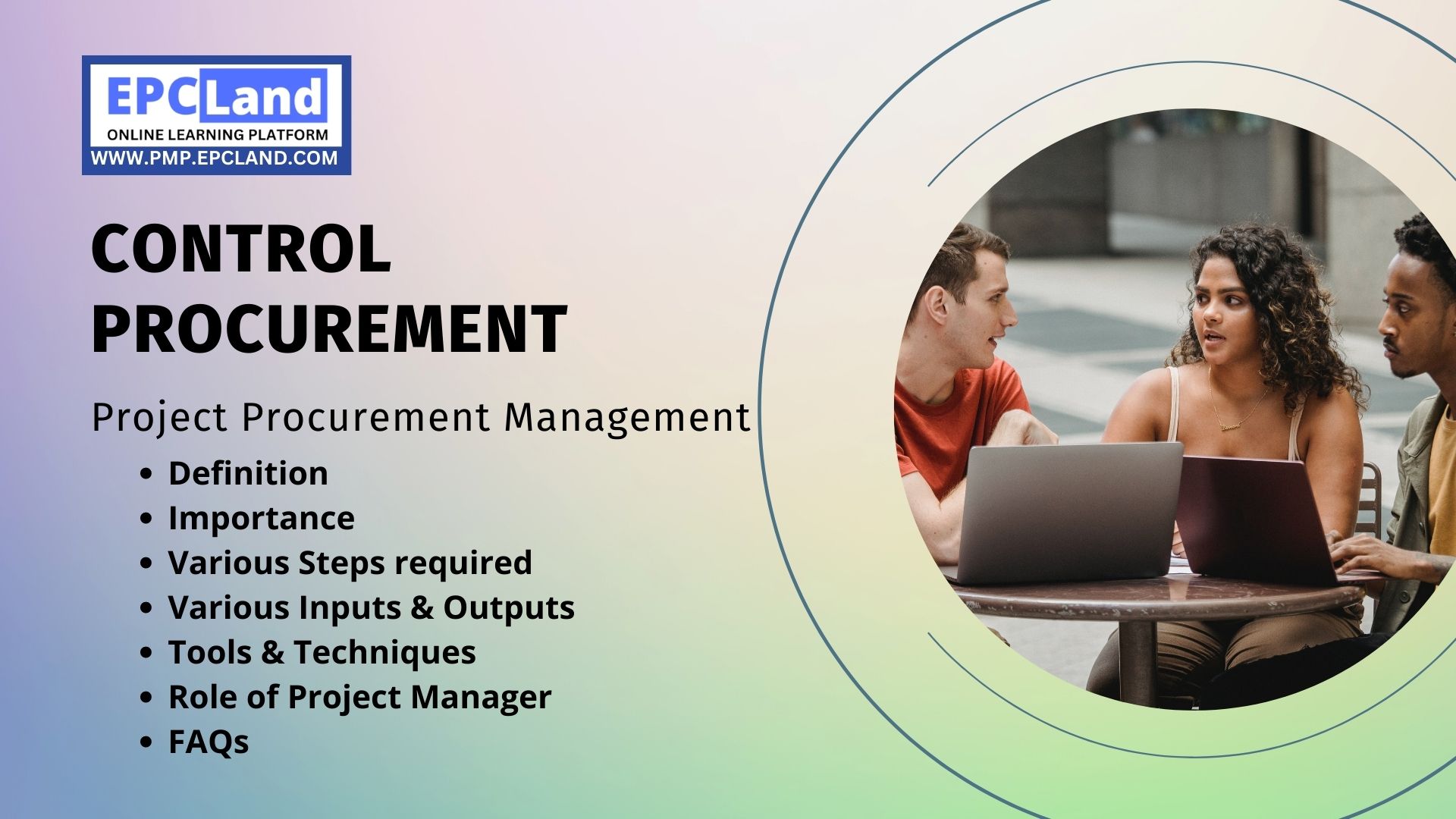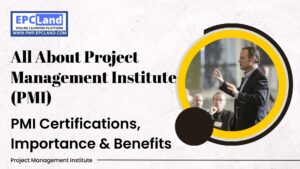Control procurement is a vital aspect of project procurement management, as it helps to ensure that the procurement process runs smoothly and efficiently. It involves monitoring and regulating the procurement process from start to finish, from identifying potential suppliers to negotiating contracts and monitoring the delivery of goods and services. Effective control procurement enables organizations to minimize risks, control costs, and achieve project goals. By implementing a robust control procurement system, organizations can ensure that procurement activities are aligned with their overall project goals, budgets, and timelines. This can result in improved supplier relationships, reduced procurement costs, and a better-quality end product. Ultimately, control procurement is a key tool for organizations looking to optimize their procurement processes and achieve success in their project management endeavors.
What is the Importance of “Control Procurement” in Project Procurement Management
Control procurement is important in project procurement management because it helps organizations to:
- Minimize risks: By monitoring and regulating procurement activities, control procurement helps to minimize risks such as cost overruns, delays, and quality issues.
- Control costs: Control procurement enables organizations to track spending and negotiate better prices, helping to control costs and ensure that procurement activities are aligned with project budgets.
- Improve quality: By monitoring the delivery of goods and services, control procurement helps organizations to ensure that procurement activities result in high-quality outcomes that meet project requirements and expectations.
- Achieve project goals: Control procurement helps to align procurement activities with overall project goals, ensuring that procurement activities contribute to the success of the project.
- Enhance supplier relationships: Control procurement enables organizations to build strong, collaborative relationships with suppliers, leading to improved communication, increased transparency, and better supplier performance.
Attempt Quiz-1 on Control Procurement Process
What are Various Steps required in “Control Procurement” in Project Procurement Management
The steps involved in control procurement in project procurement management include:
- Monitoring supplier performance: Regularly monitoring supplier performance and compliance with contract terms helps organizations to identify potential issues and address them before they become major problems.
- Evaluating supplier invoices: Reviewing and evaluating supplier invoices helps organizations to ensure that they are accurate and aligned with the agreed-upon terms and conditions.
- Tracking procurement spending: Tracking procurement spending helps organizations to monitor costs, ensure that they are within budget, and identify areas where cost savings can be made.
- Negotiating change orders: Change orders occur when the original procurement requirements change. Negotiating change orders helps organizations to ensure that they are aligned with the project’s revised goals and budgets.
- Monitoring delivery of goods and services: Monitoring the delivery of goods and services helps organizations to ensure that procurement activities are aligned with project timelines and that the end product meets quality standards.
- Documenting procurement activities: Maintaining accurate, up-to-date records of procurement activities helps organizations to ensure that procurement activities are transparent and auditable, and provides a basis for future decision-making.
- Continuously improving procurement processes: Continuously reviewing and improving procurement processes helps organizations to optimize their procurement activities and ensure that they are aligned with project goals, budgets, and timelines.
What are various Tools & Techniques used for “Control Procurement” in Project Procurement Management
There are several tools and techniques used for control procurement in project procurement management, including:
- Contract management software: Contract management software helps organizations to manage procurement contracts, track supplier performance, and monitor compliance with contract terms and conditions.
- Procurement performance metrics: Procurement performance metrics help organizations to track procurement performance and identify areas for improvement.
- Change management procedures: Change management procedures help organizations to manage changes to procurement requirements, ensuring that procurement activities are aligned with the project’s revised goals and budgets.
- Quality control techniques: Quality control techniques such as inspection and testing help organizations to ensure that procurement activities result in high-quality outcomes.
- Supply chain management tools: Supply chain management tools help organizations to manage procurement activities and monitor supplier performance, enabling organizations to optimize their procurement processes.
- Earned value management: Earned value management helps organizations to track procurement performance and determine the value of work completed, enabling organizations to make informed decisions about procurement activities.
- Vendor rating systems: Vendor rating systems help organizations to evaluate supplier performance, identify areas for improvement, and select the best suppliers for their procurement needs.
What are various Inputs required for “Control Procurement” in Project Procurement Management
The inputs required for control procurement in project procurement management include:
- Procurement management plan: The procurement management plan outlines the procurement activities for the project and provides a basis for control procurement.
- Procurement documents: Procurement documents such as contracts, purchase orders, and invoices provide the information needed to monitor procurement activities and ensure that they are aligned with project goals.
- Project management plan: The project management plan provides information about the project goals, budgets, and timelines, which are critical inputs for control procurement.
- Procurement performance reports: Procurement performance reports provide information about supplier performance, enabling organizations to monitor supplier performance and identify areas for improvement.
- Change requests: Change requests provide information about changes to procurement requirements, enabling organizations to manage changes to procurement activities.
- Quality control reports: Quality control reports provide information about the quality of procurement activities, enabling organizations to ensure that procurement activities result in high-quality outcomes.
- Financial information: Financial information such as budgets, invoices, and spending reports provide information about procurement costs, enabling organizations to control procurement costs and ensure that they are within budget.
What are various Outputs required for “Control Procurement” in Project Procurement Management
The outputs of control procurement in project procurement management include:
- Approved change requests: Approved change requests provide information about changes to procurement requirements, enabling organizations to manage changes to procurement activities.
- Procurement performance reports: Procurement performance reports provide information about supplier performance, enabling organizations to monitor supplier performance and identify areas for improvement.
- Quality control reports: Quality control reports provide information about the quality of procurement activities, enabling organizations to ensure that procurement activities result in high-quality outcomes.
- Financial reports: Financial reports provide information about procurement costs, enabling organizations to control procurement costs and ensure that they are within budget.
- Supplier performance evaluations: Supplier performance evaluations provide information about supplier performance, enabling organizations to make informed decisions about future procurement activities.
- Contract changes: Contract changes provide information about changes to procurement contracts, enabling organizations to ensure that procurement activities are aligned with project goals and budgets.
- Recommendations for improvement: Recommendations for improvement provide information about areas where procurement activities can be optimized, enabling organizations to continuously improve their procurement processes.
What is the role of Project Manager in “Control Procurement” in Project Procurement Management
The project manager plays a critical role in control procurement in project procurement management. The project manager is responsible for:
- Monitoring procurement activities: The project manager is responsible for monitoring procurement activities to ensure that they are aligned with project goals, budgets, and timelines.
- Managing change requests: The project manager is responsible for managing change requests related to procurement activities, ensuring that procurement activities are aligned with the project’s revised goals and budgets.
- Evaluating supplier performance: The project manager is responsible for evaluating supplier performance, identifying areas for improvement, and making informed decisions about future procurement activities.
- Controlling procurement costs: The project manager is responsible for controlling procurement costs, ensuring that procurement activities are within budget.
- Ensuring quality of procurement activities: The project manager is responsible for ensuring that procurement activities result in high-quality outcomes by implementing quality control techniques and reviewing quality control reports.
- Managing procurement risks: The project manager is responsible for managing procurement risks, ensuring that procurement activities are aligned with project goals, and minimizing risks to the project.
- Coordinating procurement activities with other project activities: The project manager is responsible for coordinating procurement activities with other project activities, ensuring that procurement activities are aligned with project goals and budgets.
Attempt Quiz-2 on Control Procurement Process
Final Takeaway on “Control Procurement” in Project Procurement Management
Control procurement in project procurement management is crucial for ensuring that procurement activities are aligned with project goals, budgets, and timelines, and result in high-quality outcomes. The project manager plays a key role in control procurement, monitoring procurement activities, managing change requests, evaluating supplier performance, controlling procurement costs, and coordinating procurement activities with other project activities. Effective control procurement requires inputs such as procurement management plans, procurement documents, project management plans, procurement performance reports, change requests, quality control reports, and financial information. Outputs of control procurement include approved change requests, procurement performance reports, quality control reports, financial reports, supplier performance evaluations, contract changes, and recommendations for improvement. By implementing control procurement effectively, organizations can ensure that procurement activities support project success.
FAQs on “Control Procurement” in Project Procurement Management
- What is the purpose of control procurement in project procurement management? The purpose of control procurement in project procurement management is to monitor procurement activities, ensure that they are aligned with project goals, budgets, and timelines, and result in high-quality outcomes.
- What are the responsibilities of the project manager in control procurement? The project manager is responsible for monitoring procurement activities, managing change requests, evaluating supplier performance, controlling procurement costs, ensuring quality of procurement activities, managing procurement risks, and coordinating procurement activities with other project activities.
- What are the inputs required for control procurement? The inputs required for control procurement include procurement management plans, procurement documents, project management plans, procurement performance reports, change requests, quality control reports, and financial information.
- What are the outputs of control procurement? The outputs of control procurement include approved change requests, procurement performance reports, quality control reports, financial reports, supplier performance evaluations, contract changes, and recommendations for improvement.
- How does control procurement support project success? By effectively monitoring procurement activities, controlling procurement costs, ensuring quality of procurement activities, and coordinating procurement activities with other project activities, control procurement supports project success by ensuring that procurement activities are aligned with project goals, budgets, and timelines and result in high-quality outcomes.

















